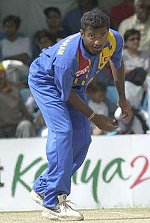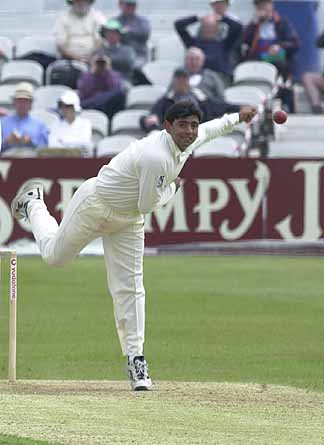The magic of spin in instant cricket
Many eyebrows were raised at the completion of the recent lowscoring one-day series between New Zealand and India
Erapalli Prasanna
31-Jan-2003
Many eyebrows were raised at the completion of the recent lowscoring one-day series between New Zealand and India. Even New
Zealand cricket's top man, Martin Snedden, was quite displeased
with the state of pitches in the series. Ironically enough,
Snedden is one person who would know more about getting smacked
around the park; he holds the dubious distinction of being the
only bowler to have conceded more than 100 runs in a World Cup
innings!
But say what you will, the nature of the one-day game is such
that it is geared for instant entertainment, and that invariably
involves the ball flying to all directions in the field. The New
Zealand series was an aberration at best, and rarely have bowlers
had such a good time in a one-day series. In fact, even the fast
bowlers have had the benefit of the new ball and early-morning
moisture to help them; it is the spinners who have been the
whipping-boys of spectacle called one-day cricket.
 © CricInfo |
Indeed, there was even a time when spinners were unwanted in oneday cricket. That changed when Imran Khan used Abdul Qadir as an
attacking option during the 1983 World Cup. Qadir obligingly
snapped up four wickets against New Zealand, and then five
against Sri Lanka. Mind you, Qadir was a complete leg-spin
bowler, a master of his craft; he had a deadly googly that
bamboozled even the very best of batsmen, and in 1983, Qadir was
possibly at the peak of his powers.
Spin played a large role in Indian one-day victories as well, and
that is a factor that most people do not recall about India
winning the Benson & Hedges World Championship in 1984/85. On the
bouncy tracks down under, India employed spin as a mode of attack
to claim wickets, a ploy that no team had effectively pursued
before. I was then the manager of the Indian team, and it was a
pleasure to see Laxman Sivaramakrishnan and Ravi Shastri bowl in
tandem, picking up wickets at regular intervals.
One absolute necessity for this strategy to work is the presence
of an astute captain who is willing to set fields for spin and
attack without qualms. Imran was a sharp leader, and so was Sunil
Gavaskar; both knew the psyches of their bowlers only too well,
and they ensured that the spinners got the fields they wanted and
bowled with the sole objective of taking wickets.
 © CricInfo |
On the other hand, if spinners bowl only to restrict, it becomes
a totally different ball game. For starters, it would allow a
batting side on 180 for two in 40 overs to easily add around 100
runs in the remaining 10. That scenario would change completely
if two spinners picked four wickets between them in their
allotted 20 overs. Any team that loses four wickets in the middle
overs will struggle to make it to 235, and that is why I believe
that spin will have an important role to play, not just in this
World Cup but in all one-day internationals.
A close analysis will reveal that it is the teams without quality
spinners that go in for bits-and-pieces medium-pacers to see
through the middle overs. The really good spinners - Shane Warne,
Muttiah Muralitharan and Saqlain Mushtaq - have taken the art of
one-day spin bowling to dizzying new levels. The game, in fact,
owes Warne much for reinventing spin; he always looks to attack,
whatever the situation, and even the fielder on the midwicket
fence becomes an attacking position when Warne weaves his magic.
As I mentioned earlier, it takes a very good captain to see to it
that a spinner succeeds in one-day cricket, and Warne was lucky
to start his career under the experienced and wily Allan Border.
Even Mark Taylor was quick to recognise the significance of
Warne's attacking role when he took over the captaincy, and one
of the consequences - Warne's match-winning performance in the
1996 World Cup semi-final against the West Indies at Mohali - is
simply unforgettable.
 © CricInfo |
Being an off-spinner myself, there is no way I can ignore
Muralitharan's contribution to this arena. The amount of turn he
gets on any surface makes him a very special talent, and it was a
pleasure to give him the CEAT International Cricketer of the Year
award last Tuesday. I am sure Arjuna Ranatunga deserves much of
the credit when people talk about the mercurial rise of
Muralitharan, but the genial off-spinner's own qualities have
helped in no small measure. I was quite moved when Murali
approached me after the awards ceremony for some help; he wanted
my advice on how to bowl to batsmen who are adept at playing the
sweep-shot. If not for the prodigious turn alone, I admire Murali
for still wanting to constantly learn and perfect his art, even
at the peak of a brilliant career.
Murali and Warne's success over the recent years has made one
thing clear - spin is no more a mere sidekick to fast bowling. It
can be devastatingly attacking in its own right, and as a
spinner, I am proud that spin is holding its own - and doing
rather well at that - not only in Test cricket but in the one-day
game as well.